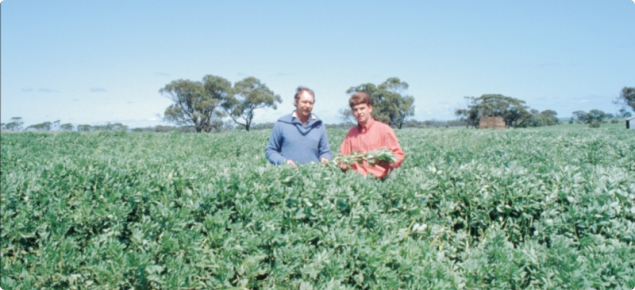Faba bean rust is not widespread in Western Australia. Low to moderate levels occur in the Esperance and Katanning regions. Individual crops suffer yield losses in some years. Rust has been recorded in the high rainfall region in the northern agricultural area around Dongara.
Faba bean rust (Uromyces viciae-fabae var. viciae-fabae) is host specific. It does not infect cereals or other break crops.
Symptoms and infection cycle
Faba bean rust has a complex life cycle with three different stages occurring through the season. Each stage produces different symptoms.
The rust fungus survives over summer in crop residues both in the paddock and as dust and trash on the seed. Rust spores produced on these residues are blown onto new crops by wind, infecting faba bean seedlings and volunteers. Infected volunteers are thought to be an important factor in the early development of rust epidemics.
Rainfall or dew is necessary for spores to infect after they land on a susceptible plant. Within 2-3 weeks new pustules form on infected leaves and stems. Spores are blown from these to spread the disease to other faba bean plants and crops. Severe rust infections cause reduction in the green leaf area during pod filling and also premature defoliation. This results in smaller seeds and yield losses of up to 30%. Yield losses can be much higher where rust occurs as a mixed infection with chocolate spot.
Aecial stage symptoms
Small creamy-yellow spots (pustules) develop on the leaves early in the season. The spores (aeciospores) produced in these pustules are wind dispersed and spread rust within the crop and to other faba bean crops.
Uredinial stage symptoms
Orange-brown pustules surrounded by a pale halo on leaves and stems soon replace the aecia. These infections are similar in appearance to rusts on cereals. If you wipe your finger over the pustule it will leave a rusty deposit. The pustules contain large numbers of spores (urediospores) that spread the disease through the crop canopy.
Telial stage symptoms
Black-brown pustules usually surrounded by a pale halo on stems and leaves appear late in the season. This is the resting stage that survives over summer. The pustules contain the resting spores (teliospores) which initiate disease the following season.
Disease risk and control
Risk factors for infection of a crop with rust are:
- sowing seed contaminated with infected seed
- spores produced on infected stubble from previous faba bean crops
- spores produced on volunteer bean plants in the previous year's faba bean stubble.
Rotate crops
It is important to isolate new crops from last years faba bean stubble by at least 500 metres.
Control volunteers
Spores produced on volunteer plants can be carried long distances by wind and will enhance the spread of the disease. Volunteers should be controlled early in the season. Where faba bean is followed by a canola crop, growers will need to use a herbicide which will kill the faba bean plants, rather than just retarding them.
Use clean seed
In areas where rust has occurred, do not use seed from paddocks in which rust was found. Sowing contaminated seed could be a method of spreading rust to new parts of Western Australia.
Know the resistance rating of your variety
Ascot, Farah, Fiesta and Fiord are all susceptible to rust. Ascochyta resistant varieties (Ascot and Farah) that are grown without routine ascochyta blight fungicide sprays are at increased risk of developing faba bean rust in favourable seasons. The ascochyta resistant variety Nura has improved resistance to rust (moderately susceptible) and has a lower risk of developing rust when grown without routine ascochyta blight fungicide sparys.
Foliar fungicides
Several fungicides are registered for use against rust but they need to be applied before severe symptoms are seen. For crops with a yield potential greater than 1.5 tonnes per hectare spraying is necessary when the leaf area affected by rust exceeds 5% before the end of flowering.
Note: recommendations were current at the time this page was prepared.


